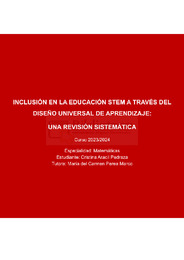Por favor, use este identificador para citar o enlazar este ítem:
https://hdl.handle.net/11000/32653Registro completo de metadatos
| Campo DC | Valor | Lengua/Idioma |
|---|---|---|
| dc.contributor.advisor | Perea, Carmen | - |
| dc.contributor.author | Aracil Pedraza, Cristina | - |
| dc.contributor.other | Departamentos de la UMH::Ciencias Sociales y Humanas | es_ES |
| dc.date.accessioned | 2024-07-23T11:20:12Z | - |
| dc.date.available | 2024-07-23T11:20:12Z | - |
| dc.date.created | 2024-06 | - |
| dc.identifier.uri | https://hdl.handle.net/11000/32653 | - |
| dc.description | Especialidad: Matemáticas | es_ES |
| dc.description.abstract | El término Diseño Universal de Aprendizaje (DUA) aparece para realizar aportes significativos a la eliminación de las barreras para el aprendizaje en las aulas. La finalidad del presente trabajo es determinar si es posible la aplicación real y efectiva del Diseño Universal de Aprendizaje en las distintas etapas educativas en el ámbito científico-tecnológico (STEM) para que se produzca una inclusión transversal, determinando las fortalezas y carencias que existen actualmente. Para conseguir este objetivo se llevó a cabo una búsqueda en Scopus, Web of Science y SciELO, de artículos en castellano y en inglés. Después de eliminar los trabajos duplicados y de aplicar los criterios de inclusión y exclusión, finalmente se obtuvieron 45 artículos. De los resultados de éstos se observa una necesidad de implementación de la filosofía del Diseño Universal de Aprendizaje por parte de los docentes y apoyados por las instituciones. También se concluye que las TIC´s pueden tener un papel relevante en el éxito de una educación inclusiva de forma holística. Futuras investigaciones podrían arrojar luz sobre el tema, ya que existe poca producción científica sobre él | es_ES |
| dc.description.abstract | The term Universal Design for Learning (UDL) appears to make significant contributions to the elimination of barriers to learning in the classroom. The purpose of this paper is to determine whether the real and effective application of Universal Design for Learning in the different educational stages in the scientific-technological field (STEM) is possible in order to produce a transversal inclusion, determining the strengths and shortcomings that currently exist. To achieve this objective, a search was carried out in Scopus, Web of Science and SciELO for articles in Spanish and English. After eliminating duplicate works and applying the inclusion and exclusion criteria, 45 articles were finally obtained. The results show that there is a need for the implementation of the Universal Design for Learning philosophy by teachers and supported by the institutions. It is also concluded that ICTs can play a relevant role in the success of inclusive education in a holistic way. Future research could shed light on the topic, as there is little scientific production on the subject | es_ES |
| dc.format | application/pdf | es_ES |
| dc.format.extent | 53 | es_ES |
| dc.language.iso | spa | es_ES |
| dc.publisher | Universidad Miguel Hernández | es_ES |
| dc.rights | info:eu-repo/semantics/openAccess | es_ES |
| dc.rights | Attribution-NonCommercial-NoDerivatives 4.0 Internacional | * |
| dc.rights.uri | http://creativecommons.org/licenses/by-nc-nd/4.0/ | * |
| dc.subject | Diseño Universal para el Aprendizaje | es_ES |
| dc.subject | STEM | es_ES |
| dc.subject | Inclusión | es_ES |
| dc.subject.other | CDU::3 - Ciencias sociales::37 - Educación. Enseñanza. Formación. Tiempo libre | es_ES |
| dc.title | Inclusión en la educación STEM a través del diseño universal de aprendizaje: una revisión sistemática | es_ES |
| dc.type | info:eu-repo/semantics/masterThesis | es_ES |

Ver/Abrir:
TFM Aracil Pedraza, Cristina.pdf
851,55 kB
Adobe PDF
Compartir:
 La licencia se describe como: Atribución-NonComercial-NoDerivada 4.0 Internacional.
La licencia se describe como: Atribución-NonComercial-NoDerivada 4.0 Internacional.
.png)